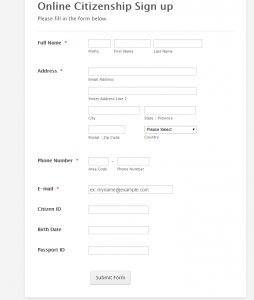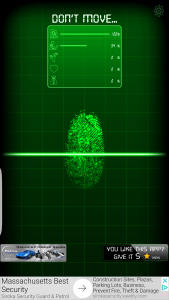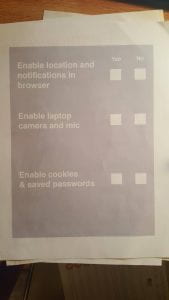Gameplay:
This game is based around the idea of privacy and government surveillance. My project is a LARP, choice driven kind of game where I act as an official from the government to help guide the player through setting up his/her first computer. The player will be given information about their character so they can get into character such as the name, email address, country, birth date, citizenship ID, bank information, passport info etc. I, the government official will give the player a set of instructions to follow in order to complete the computer set up process. Some of these instructions include joining certain wireless devices, signing up for government websites, social media sites, setting up an online banking account, enabling settings like cookies, camera on the computer, and agreeing to terms and conditions. So for these different steps, players will be presented contracts, webpages and softwares to fill in their own given personal information to complete the steps.
The choice driven aspect kicks in when players decide whether or not to put in their real information. Players can choose to either follow the instructions, or not. With that said, in the end, players will either have their privacy breached by the government if they follow the instructions, or be put on their watch list if they don’t follow instructions.
For each step, if the player chooses to put in real information, I will present them with a “notification” from the government, complimenting the player’s action and also notify the consequences of the player’s action in a satirical way. For example, a notification for choosing to enable camera / microphone would go like “your computer mic and camera will be accessed at certain times by our safety department just so we can ensure your safety. Don’t worry, you won’t even be aware when we access your camera and microphone”. Whereas if you choose not to enable camera and mic, you will receive a notification telling you “WARNING: your computer camera and mic will not be able to be accessed by us because you disabled the feature. This way, we cannot monitor you at all times to ensure your safety. You are now on your own”. So for every step that the player takes in the instructions, they will receive a notification regarding the results of their actions. So many of these notifications have a satirical aspect to them, where they reflect on what’s going on in society today in terms of privacy on the internet. These notification cards are also a way to motivate players to perhaps go back and forth between putting in real information and putting in fake information.
There really is no win state as the game ends by me telling players how much of their privacy has been breached based on how they approached the overall set up process, and telling players how much notoriety that they have from the government. I believe this game overall serves as a reflection on what’s going on in the internet today, with privacy and government surveillance issues.


The left picture shows a step where players will be given a phone where they have to choose to download these softwares or not. The screen on the right is another step where players have to choose which wifi device to join. They can choose to join the official wifi, or other alternatives.

Example of one of the forms that are required in the steps. So players choose to fill these parts in with real or fake info.






The official instructions, the different steps like terms and agreement, finger scanning, picking interests and enabling cookies / notifications / location. The last picture shows the different information of the player’s character (bank card, ID, passport), and the notifications.
Playtest:
So I playtested this game with a few people and they seemed to enjoy it, especially the notification cards that they received. I think the LARP aspect definitely brings life to this game too as we pretty much play out a scenario like in banks when you set up a bank account with an employee there. I’ve noticed that many players either went full in with filling in real info or fake info. So they don’t really go back and forth for the set up process. I think a way to fix this is to give players something to lose, so perhaps adding stats to the game. Stats like health, money, notoriety, privacy level, government watchlist level etc. And the choices that they make for each step will impact on these stats, thus motivating players to go back and forth between following and not following instructions to try to balance / prevent these stats from dropping. Perhaps I could make it so if a certain stat reaches a certain point, then the player would lose.
Artist statement:
I think my unconventional gameplay is inspired by many of the art games that we looked at in class such as September 12th, where instead of killing terrorists you actually end up killing innocent civilians. In addition to the many other games that were introduced by classmates in the indie show & tell, I think that many of the games talked about in class had significant socio cultural contexts to them. For the September 12th, it was a game criticizing the Iraq War and the controversial damages that were caused by the US military. So I really liked how this game isn’t served to entertain, but to protest against an important issue.
I think my game is also highly similar to the “Institute” that we watched in class. With players given instructions on what to do from the institute, it definitely makes the gameplay linear but also really fun and interactive, almost like a LARP. So I think my game is also very similar to that, given that it’s a LARP but also has that similar linear style gameplay to the Institute. I think the Institute screening definitely played a role behind the inspiration for this project. The idea of making things interactive in real life, by intervening certain social spaces / situations, I really wanted my game to have those elements too. My game was also highly inspired by the topics that we discussed about in regards to happenings and scores. Yoko Ono’s Grapefruit consisted many sets of instructions, guiding players to do certain things based on their own interpretations. So my work was inspired by that as you can tell, I give a set of instructions and it is up to the player on how to go about those instructions. I really liked the freedom and open to interpretation aspect to the scores created by Yoko Ono so I wanted to incorporate that into my game too.
Finally, the Dada movement in Berlin was a big inspiration for my game. Given that most of the art works made in the Berlin Dada movement was some form of protest or criticism against the government and World War 1, I wanted my game to be a work of criticism too of an issue that I’m passionate about, in this case I made it a form of criticism against privacy and government surveillance. I just really liked the idea of using art as a way to address contemporary issues because it is a great way to capture people’s attention. Hence, my game was highly based on the ideas and motivations behind the different artists that used art to criticize during the Berlin Dada movement.







 First picture taken in the score today
First picture taken in the score today The final picture of the score from today’s class
The final picture of the score from today’s class